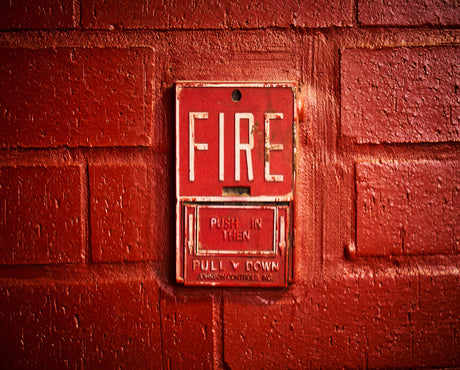
Where should fire extinguisher signs be placed?

The answer is fire extinguishers should be placed at a point to which is accessible during emergencies. While the locations mentioned in OSHA guidelines are warehouses, workplaces, healthcare exits, and construction zones, in short, any place with potential fire hazards.
But to have a clear concept we have to get into the details of OSHA and NFPA requirements for fire extinguisher placement. This guide will help you understand where should fire extinguisher signs be placed.
Fire Extinguisher Placement and Types
Did you know that the appropriate placement of fire extinguishers makes a huge impact In an emergency, This right placement and protocols are provided by The National Fire Protection Association (NFPA) on the types and placements of fire extinguishers. Why these standards? To ensure safety in various settings around the U.S. states.
From a broader perspective, a trained individual in such an industry needs to be aware of these guidelines. But we have shared the information in a way that can be understood by a layman to an experienced one. This can help prevent small fires from turning into major disasters. Let's get into the details and factors that are important to keep in mind.
- Visibility and Accessibility: The key factor is how visible your fire extinguisher is to people. So it must be installed in an easy-to-see location, ensuring that it is readily accessible in the event of a fire.
- Location: NFPA 10 dictates that exit routes and conference rooms must have extinguishers placed in common travel routes, such as hallways, exit doors, and meeting rooms.
- Obstructions: Another important factor is how accessible it is, even if it's placed at a height and visible point. If there is any obstruction or things on its way, it can be a big problem.
Common locations to place a Fire Extinguisher Sign
When putting up a fire extinguisher, be mindful of a few factors. Before moving forward a simple rule of thumb for where should fire extinguisher signs be placed? A simple guideline for placing fire extinguisher signs is to make sure they are marked so people can quickly find them in a time of need.
These are some places where you can place a fire extinguisher:
- Near the Ceiling: Putting a sign in such a place will make it easier for people to see it from far away, even if there are things around it.
- Around a Partition: So people can see the sign even if a wall is in the way.
- Nearby with Arrows: To point to where the extinguisher is.
Fire extinguishers should be on normal paths where people frequent. This is important because, during an emergency, you want people to grab it while heading for the exit, not moving away from safety. It’s also important the extinguisher is easy to see but if something is blocking it, a sign needs to show where it is.
What are the Height and Mounting Guidelines?
So let's get into the specifics of our answer of where should fire extinguisher signs be placed. The height requirement and placement depend on the size, and type of fire extinguisher. As per NFPA 10 provides clear guidelines:
- For extinguishers weighing 40 pounds or less: A top should not exceed 5 feet above the floor.
- For heavier extinguishers: The top should not exceed 3.5 feet above the floor.
- Minimum clearance: The base of each extinguisher must be at least 4 inches above the floor.
Not to forget a point and that is the Travel Distance to Extinguishers. Which means a maximum or minimum area from where it is placed. NFPA regulations specify maximum travel distances to ensure prompt access during emergencies:
- Class A and Class D hazards: No more than 75 feet of travel distance.
- Class B hazards: For lower-rated extinguishers (5-B to 20-B), they should be no more than 30 feet away.
- For higher-rated extinguishers (40-B and above), can be placed as far as 50 feet away.
- Class K hazards: (commercial Cooking areas): Must be within 30 feet of cooking surfaces.
Classification of Fire Extinguishers (NFPA standard)
Description For ordinary combustible materials such as wood, paper, and textiles.
Color Code: Green triangle
Example Usage: Fires involving paper, cloth, and wood products.
Description: For explosive class 1 liquids like gasoline, oil, and grease.
Color Code Red square.
Example Usage: Fires caused by liquids such as oil or gasoline.
Description: For electrical fires.
Color Code: Blue circle.
Example Usage: Fires involving electrical equipment, such as appliances and wiring.
Description: For combustible substances like magnesium and titanium.
Color Code: Yellow star.
Example Usage: Fires involving metals that burn at high temperatures.
Description: Specifically for kitchen fires involving cooking oils and fats.
Color Code: Black hexagon.
Example Usage: Fires occurring in commercial kitchens or cooking areas.
Key Considerations for Installation
Now let's see some of the basic considerations for the installation of a fire extinguisher.
What type of property or Building is it?
As per NFPA 1, Fire extinguishers are installed in various buildings like healthcare department hotels and restaurants, Commercial sites, and schools. Whereas Residential homes, duplexes, and manufactured homes are exceptions.
Understanding Occupancy Classifications
The above-mentioned classification of fire extinguishers is important to understand. why because it will help you decide the right type for the fire risk. This includes Light Hazard which refers to Areas with low fire risk, and Ordinary Hazard., Extra Hazard:
Specific Fire Risks
It is better to stay aware of any risk and danger as each building may have it. For example, an industrial facility might require Class D extinguishers due to the presence of flammable metals, whereas a kitchen will need Class K extinguishers.
Final words:
We can sum up the blog on where should fire extinguisher signs be placed in a way that these safety compliance standards as well as OSHA don’t have strict rules on exactly where fire extinguishers should be placed. However, the sole focus is to make it clear where fire suppression equipment is kept so that it is easy to access when there is an urgency. Do visit Olanzu to get more information on such topics!


